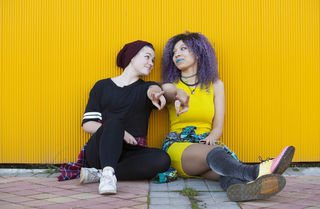
Gender
The Coming Z-Change
Generation Z will revolutionize how America thinks about gender and sexuality
Posted May 3, 2017

I have four teenaged children, members of Generation Z, and only one self-identifies as heterosexual. This is typical of their school community—the range of sexual and gender categories their classmates use to parse their inner lives makes the head of this Generation X parent spin. Few of my children’s friends identify as cisgender and heterosexual, what was considered “normal” when I was growing up in the 1980s. Instead, my teens and their classmates inhabit parts of the rainbow spectrum I never even knew existed. They are genderfluid, genderqueer, agender, bi-curious, androsexual, aromantic, demisexual—the list is long.
At first, I thought that this phenomenon was unique to the lefty, geeky, neurodiverse Californian bubble we inhabit. Our teens’ views of gender and sexuality are so radically different from older American generations (who are still having asinine arguments about which child gets to use what bathroom) that I thought our community must be on the fringe. Yet when I spoke with friends across the country, I heard similar reports about their own kids, and recent surveys suggest that these attitudes may represent a generational sea change. According to a 2016 report by trend forecasting agency J. Walter Thompson Innovation Group, only 48 percent of American 13-to-20-year-olds identify as exclusively heterosexual, and 56 percent of that same group said that they knew someone who went by gender neutral pronouns. A United Kingdom based survey in 2015 similarly found that fewer than half of 18-to-24-year-olds consider themselves to be “exclusively heterosexual.”
My observations are merely anecdotal, and the surveys I quote above are small, so we shouldn’t leap too rashly toward a conclusion. Nevertheless, it does make sense that this digital native generation, the first to be raised on social media, should be capable of radical social change. When I was an adolescent, I was influenced only by the people I knew directly or by media content produced by much older individuals. My children are influenced by youths the world over on Tumblr, Instagram and YouTube. They are also familiar with celebrities who are not just openly gay or transgender—something that was virtually unheard of when I was their age—but even openly pansexual and genderfluid, like Miley Cyrus.
When I was a young adult, the book Men Are from Mars, Women Are from Venus was a huge sensation. For anyone who is too young to remember (or who spent the 1990s in a coma), the philosophy behind the book is that men and women are fundamentally psychologically different, and that these innate differences are the main cause of strife in heterosexual relationships. I was offended by the reduction of humanity to hackneyed stereotypes and relieved when popular culture drifted away from that notion. That my children would embrace a bewildering array of new categories and labels at first struck me as counterproductive. I had thought that the goal was to get away from labels by ignoring them, as in “Sure I’ve got two X chromosomes, but I like to play ice hockey and wear baseball caps and combat boots,” or, “Sure, I’ve only had sex with women, but I’d consider having sex with a man under the right circumstances.” The way my children and their friends fit themselves into ever smaller boxes made it seem like they were moving in the opposite direction, but they have convinced me that they are not. They have just been wise enough to realize that labels and bias will never go away.
All humans are biased because we could not function without making assumptions and putting people in categories. For instance, we learn as children that the oldest person in the classroom is usually the teacher, and that makes it easier to tell who is in charge. If we kept perfectly open minds and allowed that an individual of any age might be the teacher, it would take an unacceptably long time to figure out who to ask for a bathroom pass. Similarly, if I describe a new acquaintance as someone who loves chocolate and wears sandals, it’s hard to picture that person. When I describe her as a 56-year-old Indian woman who works for a nonprofit and is married to an Israeli reporter, those on the receiving end of my description have a much crisper sense of the person I am describing, but he or she will also have all kinds of preconceived notions about what it means for the woman in question to be that age, gender and ethnicity, to work in that field and to be married to such a person.
By greatly increasing the number of possible categories by which they self-identify, Generation Z may have found a way to confer more granularity to their personal identities and weaken the power of labels at the same time. Sexual orientation and gender identity are not necessarily stable over time, they tell me; people can shift from one category to another. If someone who is agender marries someone who is transfeminine but later identifies as bigender, who is from Mars and who is from Venus? Who is supposed to bring home the bacon, and who is supposed to wash the dishes? Our concepts of what it means to be gender normative go out the window, and there is a brand new blank page to start from.
We can’t be certain that a sea change will come as the next generation enters adulthood, but I hope it will. I am sick and tired of grownups in this country telling children that they are banned from the bathroom and that a woman shouldn’t be president because females are too irrational. I would not be at all sorry to see those petty people turn wide-eyed and slack-jawed at the sight of a Generation Z tsunami sweeping America. Most of all, though, I want my children to live in a world where they can be themselves and love whom they want without being judged for it.

